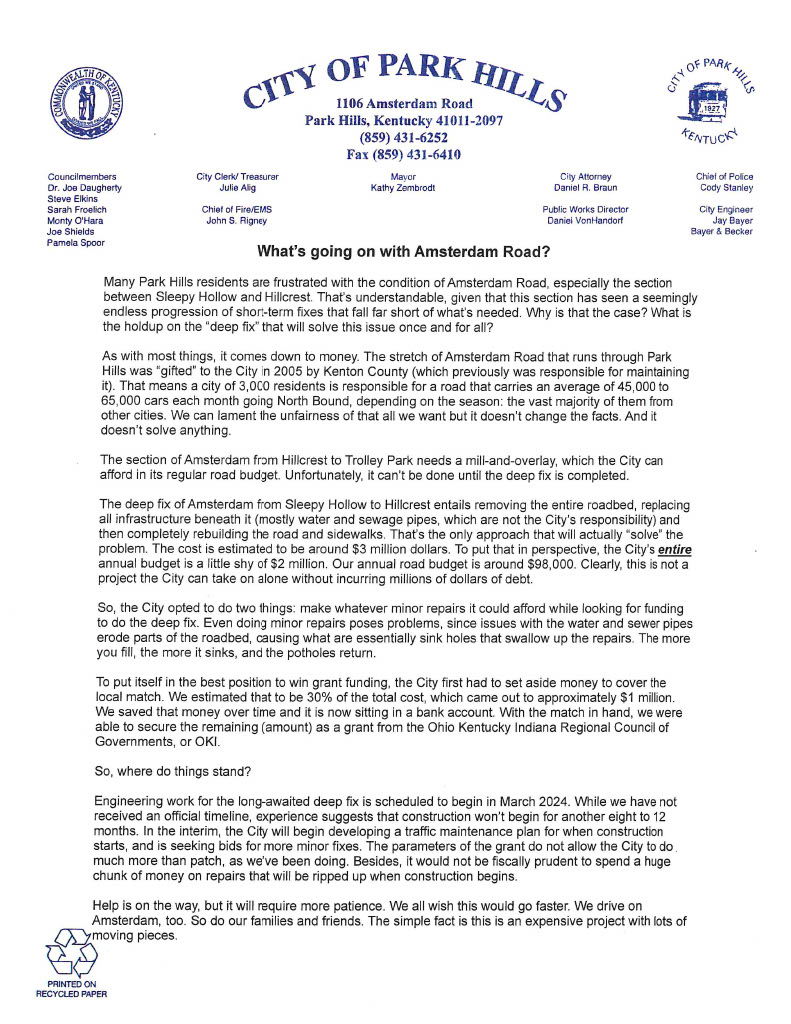
Many Park Hills residents are frustrated with the condition of Amsterdam Road, especially the section between Sleepy Hollow and Hillcrest. That’s understandable, given that this section has seen a seemingly endless progression of short-term fixes that fall far short of what’s needed. Why is that the case? What is the holdup on the “deep fix” that will solve this issue once and for all?
As with most things, it comes down to money. The stretch of Amsterdam Road that runs through Park Hills was “gifted” to the City in 2005 by Kenton County (which previously was responsible for maintaining it). That means a city of 3,000 residents is responsible for a road that carries an average of 45,000 to 65,000 cars each month going North Bound, depending on the season: the vast majority of them from other cities. We can lament the unfairness of that all we want but it doesn’t change the facts. And it doesn’t solve anything.
The section of Amsterdam from Hillcrest to Trolley Park needs a mill-and-overlay, which the City can afford in its regular road budget. Unfortunately, it can’t be done until the deep fix is completed.
The deep fix of Amsterdam from Sleepy Hollow to Hillcrest entails removing the entire roadbed, replacing all infrastructure beneath it (mostly water and sewage pipes, which are not the City’s responsibility) and then completely rebuilding the road and sidewalks. That’s the only approach that will actually “solve” the problem. The cost is estimated to be around $3 million dollars. To put that in perspective, the City’s entire annual budget is a little shy of $2 million. Our annual road budget is around $98,000. Clearly, this is not a project the City can take on alone without incurring millions of dollars of debt.
So, the City opted to do two things: make whatever minor repairs it could afford while looking for funding to do the deep fix. Even doing minor repairs poses problems, since issues with the water and sewer pipes erode parts of the roadbed, causing what are essentially sink holes that swallow up the repairs. The more you fill, the more it sinks, and the potholes return.
To put itself in the best position to win grant funding, the City first had to set aside money to cover the local match. We estimated that to be 30% of the total cost, which came out to approximately $1 million. We saved that money over time and it is now sitting in a bank account. With the match in hand, we were able to secure the remaining (amount) as a grant from the Ohio Kentucky Indiana Regional Council of Governments, or OKI.
So, where do things stand?
Engineering work for the long-awaited deep fix is scheduled to begin in March 2024. While we have not received an official timeline, experience suggests that construction won’t begin for another eight to 12 months. In the interim, the City will begin developing a traffic maintenance plan for when construction starts, and is seeking bids for more minor fixes. The parameters of the grant do not allow the City to do much more than patch, as we’ve been doing. Besides, it would not be fiscally prudent to spend a huge chunk of money on repairs that will be ripped up when construction begins.
Help is on the way, but it will require more patience. We all wish this would go faster. We drive on Amsterdam, too. So do our families and friends. The simple fact is this is an expensive project with lots of moving pieces.
We appreciate everyone’s patience on this.